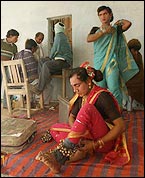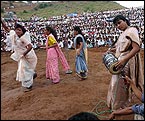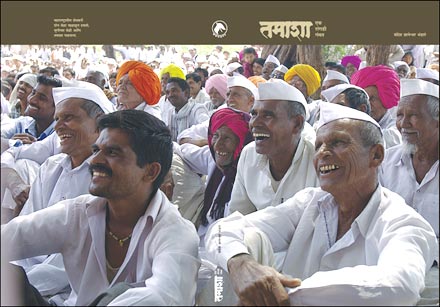|
|
 |

  |
| |

 Sandesh Bhandare is a free lance photographer and graphic designer based in Pune. He has a Diploma in Commercial Arts and has mounted different exhibitions of his work. In 1995, the National Centre of Performing Arts (NCPA) exhibited his pictures, which were a study of the Puneri Brahmins. His pictures looked at different instances in the lives of these Brahmins in the modern context. Then in 1999 he did a project called �Niche� which explored the different kinds of niches in homes, in offices, niches as part of the architectural design, etc. He was curious to see how these different niches were put to use-whether as a space for lighting lamps or for storing files. His recent book on Tamasha is a photographic journey that explores the performing art form and the lives of the people practicing it. Here Sandesh Bhandare talks to Mumbai Theatre Guide about his book and of some of the key issues facing this indigenous, folk art form of Maharashtra.
Sandesh Bhandare is a free lance photographer and graphic designer based in Pune. He has a Diploma in Commercial Arts and has mounted different exhibitions of his work. In 1995, the National Centre of Performing Arts (NCPA) exhibited his pictures, which were a study of the Puneri Brahmins. His pictures looked at different instances in the lives of these Brahmins in the modern context. Then in 1999 he did a project called �Niche� which explored the different kinds of niches in homes, in offices, niches as part of the architectural design, etc. He was curious to see how these different niches were put to use-whether as a space for lighting lamps or for storing files. His recent book on Tamasha is a photographic journey that explores the performing art form and the lives of the people practicing it. Here Sandesh Bhandare talks to Mumbai Theatre Guide about his book and of some of the key issues facing this indigenous, folk art form of Maharashtra.
|
MTG editorial
What inspired you to undertake a project on Tamasha?
In 2001, I exhibited my pictures of the Akhaada (the space where wrestling matches take place).  Wrestling matches take place all over Maharashtra and are quite popular during the times of the jatra (pilgrimage). While undertaking the jatra, there are many people who still believe that their male child�s back should at least once come in contact with the hard ground and that is another reason why Kushti (wrestling) is favoured by them. It was during this project that I noticed that the same people were fond of also watching Tamasha, whether it took place during the day or in the evening or at night. The viewing of a Tamasha is an integral part of life in small cities, towns and villages of Maharashtra. Like the wrestling matches, Tamasha performances are also popular. People from the different villages invite Tamasha troupes for their annual jatra be it for God Khandoba or for Dhairoba or for a Goddess like Bhavani. It is common to see both Kushti and Tamasha during the jatra and often villagers will give equal importance to both. Their savings for entertainment purposes would be spent equally between Kushti and Tamasha. Soon I found that the Tamasha which the villagers in Western Maharashtra enjoy watching with their families is quite different from the Tamasha of well-known theatre companies like �ChauPhula� and from its political counterparts. I noticed that entire families, complete with girls and young children would watch these performances. In such a social context I felt the need to know more about this regional art form which could have different meanings in different contexts. Earlier as a photographer-journalist I had been to Narayangaon (an important centre for Tamasha in Maharashtra) to get a first hand experience of the art form but was perhaps then not mentally prepared. I came back to the city within three days because I could not bear the kind of life I saw there. Later with my project on the Akhaada I was inspired to look at the form once again. Fortunately the India Foundation for Art (IFA) accepted my proposal and I was able to undertake the project on Tamasha. Wrestling matches take place all over Maharashtra and are quite popular during the times of the jatra (pilgrimage). While undertaking the jatra, there are many people who still believe that their male child�s back should at least once come in contact with the hard ground and that is another reason why Kushti (wrestling) is favoured by them. It was during this project that I noticed that the same people were fond of also watching Tamasha, whether it took place during the day or in the evening or at night. The viewing of a Tamasha is an integral part of life in small cities, towns and villages of Maharashtra. Like the wrestling matches, Tamasha performances are also popular. People from the different villages invite Tamasha troupes for their annual jatra be it for God Khandoba or for Dhairoba or for a Goddess like Bhavani. It is common to see both Kushti and Tamasha during the jatra and often villagers will give equal importance to both. Their savings for entertainment purposes would be spent equally between Kushti and Tamasha. Soon I found that the Tamasha which the villagers in Western Maharashtra enjoy watching with their families is quite different from the Tamasha of well-known theatre companies like �ChauPhula� and from its political counterparts. I noticed that entire families, complete with girls and young children would watch these performances. In such a social context I felt the need to know more about this regional art form which could have different meanings in different contexts. Earlier as a photographer-journalist I had been to Narayangaon (an important centre for Tamasha in Maharashtra) to get a first hand experience of the art form but was perhaps then not mentally prepared. I came back to the city within three days because I could not bear the kind of life I saw there. Later with my project on the Akhaada I was inspired to look at the form once again. Fortunately the India Foundation for Art (IFA) accepted my proposal and I was able to undertake the project on Tamasha.
Apparently many people have studied Tamasha over different periods of time. I personally recall a Ph.D. thesis done by Tevia Abrahams, which is available at the NCPA. You too must have read other people�s work on this subject. How different then is your book from the work done by scholars before you?
As far as possible I was keen to look at contemporary Tamasha; to see what shades it has taken on in our 21st century. New trends keep coming in because it is after all a popular art form. Some concepts like the vagnatya which we relate with the Tamasha came in much later as the form was first and foremost influenced by our oral tradition. The powada too evolved over time. Noted scholars like R.C. Dhene have written extensively about the different elements that are found in the Tamasha and I haven�t tried to replace their findings but rather their research helped me to better understand what I was seeing. I could for instance make out perceptible differences between the performances by different castes of people like the Kolhatis, the Zombadis and even in those Tamasha performances performed by the people who practice Gondhal.
Apart from the socio-cultural factors in which the art form exists, you also hold the economic factor to be very relevant. Can you elaborate on it?
Economics plays a very crucial role in Tamasha. Most of the people who are involved with the form are landless labourers. Again barring  few names like Patthe Bapurao, most of the people who practice the form are not Brahmins but low caste people. Opportunities to a better life are rarely made available to these people. A supari (commission) for a Tamasha performance can range between Rs. 40,000 to Rs. 1,00,000 for a night. Sometimes it can be as low as Rs. 8,000 or 10,000. You will find that the Tamasha groups themselves are structured along price differences. Then it is not that these artistes get to perform for the whole year. There are dry spells, which makes it difficult for them to sustain their livelihood. On an average they must do about 200 to 250 shows in a period of seven months. Their minimum expenses are Rs. 20,000 for a show. In commissioned performances for the jatra, a fixed amount is assured but for ticketed shows, it is not the same. The risk is more. Of course there are auspicious dates in the year when there are not enough Tamasha companies to fulfill all jatras. The highest bidders get the performances they want. In the chaitra month alone companies can make more than they would be able to in six months. But these opportunities are few and far between. For the most part it is a difficult journey as there are very little savings. few names like Patthe Bapurao, most of the people who practice the form are not Brahmins but low caste people. Opportunities to a better life are rarely made available to these people. A supari (commission) for a Tamasha performance can range between Rs. 40,000 to Rs. 1,00,000 for a night. Sometimes it can be as low as Rs. 8,000 or 10,000. You will find that the Tamasha groups themselves are structured along price differences. Then it is not that these artistes get to perform for the whole year. There are dry spells, which makes it difficult for them to sustain their livelihood. On an average they must do about 200 to 250 shows in a period of seven months. Their minimum expenses are Rs. 20,000 for a show. In commissioned performances for the jatra, a fixed amount is assured but for ticketed shows, it is not the same. The risk is more. Of course there are auspicious dates in the year when there are not enough Tamasha companies to fulfill all jatras. The highest bidders get the performances they want. In the chaitra month alone companies can make more than they would be able to in six months. But these opportunities are few and far between. For the most part it is a difficult journey as there are very little savings.
Personally I am not very sentimental about issues such as the preservation of indigenous, folk art forms. For me what is more important is that people should lead better lives, have access to better education, health facilities etc. The art form is important but it should not become its own victim. It perhaps pleases our cultural vanity to moan the death of the jester (songadya) in Tamasha but how many of us want to accept that these jesters simply missed out on things like primary education in their real lives.

|
|
|
|
|
 |


|  |

|

